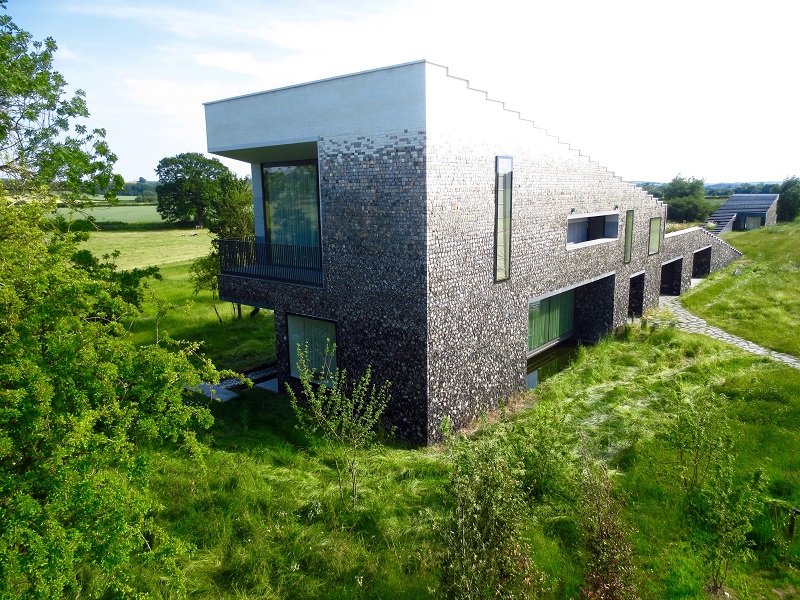Durability

|
Durability is the resistance to degradation of products, materials, buildings and other built assets over time. This can be a difficult property to assess - whilst a tough material may be hard to the touch but it may also be non-durable if it decomposes or is eroded in a relatively short period of time.The opposite can also be true.
Many factors affect durability, whether concerning the nature of the material itself or the way it has been assembled with other materials:
- Molecular structure.
- Resistance to damp, moisture and water.
- Resistance to corrosive substances.
- Resistance to vermin and other aggressive animal life such as wood boring beetles.
- Resistance to mould and rot.
- Fire resistance.
- Ability to accept movement.
- Resistance to atmospheric pollution.
- Resistance to heat and cold.
- Capacity for moisture absorption.
- Surface profiles, orientation, texture and colour.
As well as its constituent materials, a building as a complete entity may also be said to be durable (or non-durable). Buildings constructed for temporary purposes, such as demountable site cabins and exhibition pavilions, do not tend to stand the test of time because they are not designed to.
A building will be subjected not only to daily wear and tear from users but also to the constant influence of climate – in particular rain, frost, sun and heat – forces collectively referred to as weathering. Such forces can cause significant deterioration and therefore a reduction in durability.
As well as diminishing durability, weathering forces can also result in a change of appearance – usually a change for the worse – however some materials can be affected beneficially: some stones and brick types for example, as well as some metals such as copper which develop a patina.
As well as causing potential staining – particularly in polluted areas – some forms of weathering e.g acid rain, result in chemical actions which can cause deterioration of the building fabric. Changes in moisture content, temperature, frost, sunlight, soil and groundwater action, atmospheric pollution and the action of electrolytes, mould and insect attack can lead to corrosion, erosion and disintegration of materials and construction details. Materials must therefore be carefully understood and specified according to their properties, their juxtaposition with other materials in the building and the potential destructive agents they may face.
Design can have a direct effect on durability: even the best materials may deteriorate prematurely if they are not adequately maintained, and a design which makes this difficult e.g timberwork that is inaccessible and so infrequently painted, will have adverse effects on component durability. Sometimes, designers must face a trade-off between the initial costs of materials and the likely future costs of maintenance and the resulting effect on durability.
Economic considerations will play a significant part in determining the durability of a construction: the best possible materials assembled in a considered, careful way tends to be the costliest method of approach yet this may frequently result in best quality and longest durability.
Durability is becoming more of a concern in relation to the likely impact of climate change, in particlular, higher temperatures, rising water levels and more frequent extreme weather events.
In some cases buildings may be designed to be deconstructed, as well as being durable, so that at the end of their lives, they can be easily recycled or re-used.
[edit] Related articles on Designing Buildings Wiki
- Approved documents.
- Approved document 7.
- BREEAM Material efficiency.
- Building Regulations.
- Construction buyer.
- Conversion of material volumes.
- Defects.
- Off-site goods and materials.
- Material handling.
- Materials on site.
- Mohs scale of mineral hardness.
- Performance gap.
- Polypropylene.
- Quality control.
- Schedule of defects.
- Snagging.
- Supply.
- Testing construction materials.
- Truth to materials.
Featured articles and news
A change to adoptive architecture
Effects of global weather warming on architectural detailing, material choice and human interaction.
How big is the problem and what can we do to mitigate the effects?
Overheating guidance and tools for building designers
A number of cool guides to help with the heat.
The UK's Modern Industrial Strategy: A 10 year plan
Previous consultation criticism, current key elements and general support with some persisting reservations.
Building Safety Regulator reforms
New roles, new staff and a new fast track service pave the way for a single construction regulator.
Architectural Technologist CPDs and Communications
CIAT CPD… and how you can do it!
Cooling centres and cool spaces
Managing extreme heat in cities by directing the public to places for heat stress relief and water sources.
Winter gardens: A brief history and warm variations
Extending the season with glass in different forms and terms.
Restoring Great Yarmouth's Winter Gardens
Transforming one of the least sustainable constructions imaginable.
Construction Skills Mission Board launch sector drive
Newly formed government and industry collaboration set strategy for recruiting an additional 100,000 construction workers a year.
New Architects Code comes into effect in September 2025
ARB Architects Code of Conduct and Practice available with ongoing consultation regarding guidance.
Welsh Skills Body (Medr) launches ambitious plan
The new skills body brings together funding and regulation of tertiary education and research for the devolved nation.
Paul Gandy FCIOB announced as next CIOB President
Former Tilbury Douglas CEO takes helm.
UK Infrastructure: A 10 Year Strategy. In brief with reactions
With the National Infrastructure and Service Transformation Authority (NISTA).
Ebenezer Howard: inventor of the garden city. Book review.
Airtightness Topic Guide BSRIA TG 27/2025
Explaining the basics of airtightness, what it is, why it's important, when it's required and how it's carried out.





















